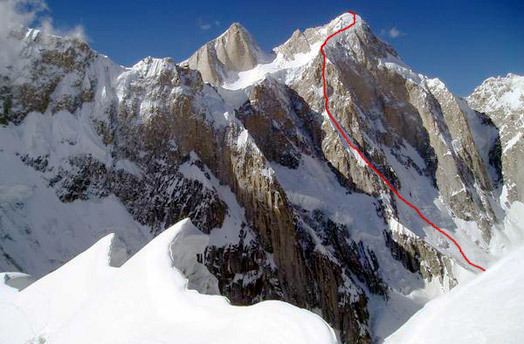
Pumari Chish South (7350m), Karakoram, Pakistan, showing the approximate
line of the first ascent, accomplished over five days in alpine style in
early June by French climbers Yannick Graziani and Christian Trommsdorff.
While the pair declined to rate the route, Trommsdorff remarked that if the
route were in the Alps–on a mountain half the size, and half the altitude–it
would be graded Extreme Difficile. As it was, he compared the 2700-meter
climb to the 2006 ascent, by Marko Prezelj and Boris Lorencic, of the
Northwest Pillar (ED2: M6+ 70 degrees, 1950m) of Tibet’s Chomolhari (7326m),
noting that the steep headwall, at nearly 7000 meters, makes for a climb he
deemed harder than the 2006 ascent. [Photo] Yannick Graziani / Courtesy of www.mountain.ru
On June 12, French climbers Yannick Graziani and Christian Trommsdorff made the first ascent, in pure alpine style, of Pumari Chish South (7350m), a remote peak in the Hispar Muztagh of Pakistan’s Karakoram Range. The duo, who had attempted the peak four years ago, also in alpine style, ascended the 2700-meter-high south face over the course of five days, establishing the first ascent of, as Trommsdorff said, “the most beautiful unclimbed peak I know of.”
Having skied into the West Yutmaru Glacier, Graziani and Trommsdorff began working up a 60-degree snow ramp on the east side of the south face on June 8. After three days of steep snow climbing, the pair reached the base of the headwall at 6700 meters.
After two days of mostly steep snow and ice climbing, at the top of the ramp (ca. 6400m) is the first key section to get to the second snow field, where the team established their third bivy. From there were three 40-meter pitches, the first and hardest of which was vertical M6 with an overhanging icy crack. Two magnificent M5 pitches, aiming diagonally left up to the snowfield, followed. They bivied 50 meters from the top of the snowfield at 6600 meters, and in the evening sun climbed and fixed the two pitches above the snowfield, the second being the key overhanging chimney/dihedral (so they would not have to climb it during the cold morning, as no sun hit the face before 10 a.m.).
They climbed the vertical, ice-choked, 300-meter rock pillar all free except the overhanging dihedral, which required one thirty-meter section of aid. Atop the headwall (7000m), they bivied and made a 350-meter ridgeline push for the summit on June 12, reaching the domed top of the virgin peak the same day. Some downclimbing and around thirty-five rappels (many of them diagonal to shortcut back to the snow ramp along the ascent route, with some shortcuts when the ascent line was “slaloming a bit”) took them to base camp a day and a half later. The pair had fine weather for the entire week except for 80 km/h winds the morning that they made the summit.
Trommsdorff compares the steep and icy terrain of most of the route with the north face of the Eiger, but notes that the steep headwall, at nearly 7000 meters, makes for a climb he deemed harder than Marko Prezelj and Boris Lorencic’s 2006 ascent of the Northwest Pillar (ED2: M6+ 70 degrees, 1950m) of Tibet’s Chomolhari (7326m). (That climb won the 2007 Piolet d’Or, of which Trommsdorf comprised part of the jury; Prezelj, who led all the route, ultimately declined the award.) Of the headwall rock, Trommsdorff said, “The granite is nicer than anything in Chamonix.”
The line was tried first by Julie Ann Clyma and Roger Payne, the Kiwi-British couple, in both 1999 and 2000. That pair was disappointed both years by unfortunate weather at relatively low elevations (6200m and 5300m) below the headwall. On the first French attempt in May of 2003, Graziani and Trommsdorff high-marked a couple pitches above the aid section (ca. 6750m). Their “very bad bivouac” was swamped with spindrift all night, and they were forced to descend. Their second attempt, in mid-June, took them to 6900 meters, two pitches below the ridge, and snow again convinced them to retreat. The 2004 American Alpine Journal relays that on their second descent “at around 6500m, [Graziani and Trommsdorff] witnessed the huge seracs, which threaten the lower section of the face, explode. The resulting avalanche wiped the approach clean, filling the valley below with an enormous cloud and even affecting base camp some four kilometers distant. The two promptly descended and went home.”
The pair are no strangers to difficult alpine climbs in the greater ranges: in April 20005, they participated in a French expedition that established a number of new routes on Nepal’s Chomo Lonzo massif (see the note here). Trommsdorff reports that they are pleased to have returned to Pumari Chish South, which they again found to be one of the most sustained, committing and inspiring climbs they have done at altitude.